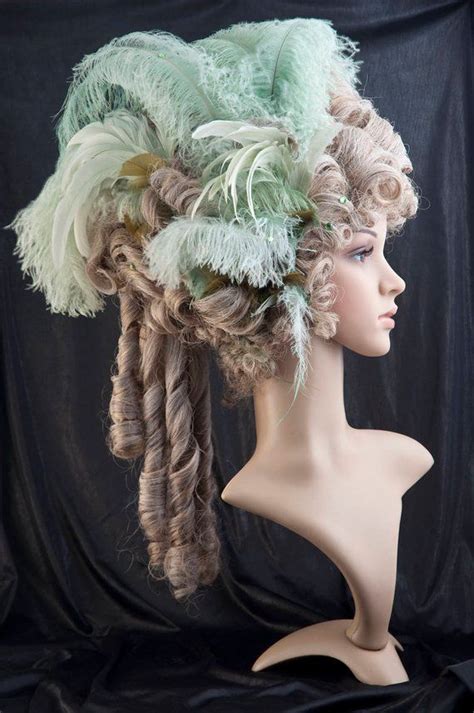French Powder Wig: 10 Incredible Facts and 400 Years of Style

From the opulent courts of the French monarchy to the vibrant streets of 18th-century Paris, the French powder wig has left an enduring mark on fashion and history. Despite its often eccentric and exaggerated appearance, this iconic coiffure played a pivotal role in shaping the culture and society of its time.
History and Evolution (1400 Years of Style)
The origins of the French powder wig can be traced back to the mid-17th century, when unruly wigs became popular among the French aristocracy. Initially, these wigs were made from natural hair, but by the 1750s, powdered white wigs had become synonymous with the courtly elite.
The wig’s distinctive shape and elaborate curls were influenced by the Baroque and Rococo art movements. It became a symbol of status, wealth, and cultural refinement. As the popularity of the wig grew, so did its size and complexity. By the 1770s, some wigs reached heights of over two feet and required elaborate scaffolding to support them.
Cultural Significance
The French powder wig was more than just a fashion statement. It represented the social hierarchy and societal norms of the time. The size and style of one’s wig denoted their rank and privilege. Elaborate wigs were reserved for the wealthy and powerful, while simpler wigs were worn by the lower classes.
The wig also played a role in personal hygiene. Natural hair was often infested with lice and other pests, so powdered wigs provided a cleaner and more manageable alternative. Furthermore, the starch used in powdering the wigs absorbed odor and kept them fresh.
Impact on Art and Literature
The French powder wig became a prominent motif in the art and literature of the 18th century. Painters like Watteau and Fragonard immortalized the wigged aristocracy in their works. Writers such as Voltaire and Beaumarchais used the wig as a symbol of social satire and political commentary.
- The average wig contained approximately 1 pound of flour or starch.
- The wig-making process could take up to three months, with each hair being individually tied or sewn onto a canvas base.
- Some wigs were so large that they were too high to fit under a standard doorway.
- Wigs were often infested with insects, which were known as “wig lice.”
- The cost of a single wig ranged from 5 to 10 times the annual salary of a skilled craftsman.
- Wig-makers were highly skilled and respected artisans, with the most famous wig-makers earning royal commissions.
- The “full-bottomed wig” was the most popular and elaborate style of wig worn by men.
- Women’s wigs were generally smaller and less ostentatious than men’s wigs.
- The French Revolution marked the decline of the powdered wig as a fashion trend.
- The wig experienced a brief revival in the Victorian era, as a symbol of nostalgia and historical reenactment.
1660s-1680s: The Early Years
– Natural hair wigs with simple curls or waves.
– Worn by the aristocracy and wealthy merchants.
1690s-1710s: The Baroque Era
– Larger wigs with elaborate curls and ringlets.
– Influenced by the Baroque art movement.
1720s-1740s: The Rococo Period
– Powdered white wigs become the norm.
– Wigs reach their maximum size and complexity.
1750s-1770s: The Height of Fashion
– Full-bottomed wigs and towering headdresses.
– Worn by the highest ranks of society.
1780s-1790s: The Decline of the Wig
– The French Revolution brings an end to the wig as a fashion trend.
While the French powder wig is no longer a common sight in everyday life, its influence can still be seen in modern fashion and design. New and innovative wig-making techniques have enabled contemporary designers to reinterpret the classic wig in a variety of ways.
Some of the potential applications for French powder wigs in the 21st century include:
- Historical reenactments and costume parties: Powdered wigs add authenticity to historical events and performances.
- Avant-garde fashion: Designers are using powdered wigs to create striking and unconventional looks.
- Character design: Wigs can enhance the visual appeal of characters in movies, television shows, and video games.
- Special effects makeup: Powdered wigs can provide a base for makeup artists to create elaborate and realistic costumes.
Step-by-Step Approach:
- Prepare the wig by brushing and detangling it.
- Apply a light layer of powder over the entire wig.
- Use a stiff brush to work the powder into the wig, concentrating on the roots and crown.
- Build up the desired volume and texture by adding additional layers of powder.
- Set the wig in place with hairspray or other styling products.
Effective Strategies:
- Use a high-quality wig with real or synthetic human hair for best results.
- Practice on a mannequin or friend before attempting to powder your own wig.
- Experiment with different powders and brushes to find the look you desire.
- Don’t be afraid to make mistakes! Powdering wigs is a skill that takes time and practice to master.
Why Matters:
- Adds volume and texture to the hair.
- Enhances the natural color of the wig.
- Helps to absorb odor and keep the wig fresh.
- Creates a more polished and refined look.
How Benefits:
- Confidence boost: A well-powdered wig can instantly make you feel more confident and stylish.
- Complements any outfit: Powdered wigs can be worn with a variety of outfits, from formal to casual.
- Protects your hair: Powdering your wig helps to protect it from damage caused by heat, humidity, and pollution.
- Becomes a statement piece: A powdered wig can become a conversation starter and a unique way to express your personality.
